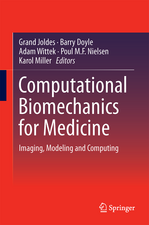Computational Biomechanics for Medicine
Editat de Karol Miller, Poul Nielsenen Limba Engleză Paperback – 22 aug 2016
| Toate formatele și edițiile | Preț | Express |
|---|---|---|
| Paperback (1) | 966.90 lei 38-44 zile | |
| Springer – 22 aug 2016 | 966.90 lei 38-44 zile | |
| Hardback (1) | 1092.06 lei 6-8 săpt. | |
| Springer – 14 mar 2010 | 1092.06 lei 6-8 săpt. |
Preț: 966.90 lei
Preț vechi: 1017.80 lei
-5% Nou
Puncte Express: 1450
Preț estimativ în valută:
185.04€ • 192.47$ • 152.76£
185.04€ • 192.47$ • 152.76£
Carte tipărită la comandă
Livrare economică 11-17 aprilie
Preluare comenzi: 021 569.72.76
Specificații
ISBN-13: 9781493940394
ISBN-10: 1493940392
Pagini: 155
Ilustrații: XII, 155 p.
Dimensiuni: 155 x 235 mm
Greutate: 0 kg
Ediția:Softcover reprint of the original 1st ed. 2010
Editura: Springer
Colecția Springer
Locul publicării:New York, NY, United States
ISBN-10: 1493940392
Pagini: 155
Ilustrații: XII, 155 p.
Dimensiuni: 155 x 235 mm
Greutate: 0 kg
Ediția:Softcover reprint of the original 1st ed. 2010
Editura: Springer
Colecția Springer
Locul publicării:New York, NY, United States
Descriere
Mathematical modelling and computer simulation have proved tremendously successful in engineering. One of the greatest challenges for mechanists is to extend the success of computational mechanics to fields outside traditional engineering, in particular to biology, biomedical sciences, and medicine. The proposed workshop will provide an opportunity for computational biomechanics specialists to present and exchange opinions on the opportunities of applying their techniques to computer-integrated medicine. For example, continuum mechanics models provide a rational basis for analysing biomedical images by constraining the solution to biologically reasonable motions and processes. Biomechanical modelling can also provide clinically important information about the physical status of the underlying biology, integrating information across molecular, tissue, organ, and organism scales. The main goal of this workshop is to showcase the clinical and scientific utility of computational biomechanics in computer-integrated medicine.
Cuprins
Computational biomechanics of soft tissues and flow.- Patient-Specific Modelling of Cardiovascular and Respiratory Flow Problems – Challenges.- MRI Tissue Segmentation Using a Variational Multilayer Approach.- Mapping Microcalcifications Between 2D Mammograms and 3D MRI Using a Biomechanical Model of the Breast.- Accuracy of Non-linear FE Modelling for Surgical Simulation: Study Using Soft Tissue Phantom.- Patient-Specific Hemodynamic Analysis for Proximal Protection in Carotid Angioplasty.- Cortical Surface Motion Estimation for Brain Shift Prediction.- Method for Validating Breast Compression Models Using Normalised Cross-Correlation.- Can Vascular Dynamics Cause Normal Pressure Hydrocephalus?.- Computational biomechanics of tissues of musculoskeletal system.- Computational Modelling of Human Gait: Muscle Coordination of Walking and Running.- Influence of Smoothing on Voxel-Based Mesh Accuracy in Micro-Finite Element.- Biomaterial Surface Characteristics Modulate the Outcome of Bone Regeneration Around Endosseous Oral Implants: In Silico Modeling and Simulation.- Subject-Specific Ligament Models: Toward Real-Time Simulation of the Knee Joint.- Ergonomic Assessment of Hand Movements in Laparoscopic Surgery Using the CyberGlove®.- Effects of Fetal Head Motion on Pelvic Floor Mechanics.- Novel Monitoring Method of Proximal Caries Using Digital Subtraction Radiography.
Textul de pe ultima copertă
Mathematical modelling and computer simulation have proved tremendously successful in engineering. One of the greatest challenges for mechanists is to extend the success of computational mechanics to fields outside traditional engineering, in particular to biology, biomedical sciences, and medicine. The proposed workshop will provide an opportunity for computational biomechanics specialists to present and exchange opinions on the opportunities of applying their techniques to computer-integrated medicine. For example, continuum mechanics models provide a rational basis for analysing biomedical images by constraining the solution to biologically reasonable motions and processes. Biomechanical modelling can also provide clinically important information about the physical status of the underlying biology, integrating information across molecular, tissue, organ, and organism scales. The main goal of this workshop is to showcase the clinical and scientific utility of computational biomechanics in computer-integrated medicine.
Caracteristici
Introduces a novel partnership between surgeons and machines that helps overcome the limitations of traditional surgery
Covers Computer-Integrated Surgery systems that can improve clinical outcomes and the efficiency of health care delivery
With contributions from institutions such as Harvard, MIT, Cambridge, Imperial College, etc.
Includes supplementary material: sn.pub/extras
Covers Computer-Integrated Surgery systems that can improve clinical outcomes and the efficiency of health care delivery
With contributions from institutions such as Harvard, MIT, Cambridge, Imperial College, etc.
Includes supplementary material: sn.pub/extras








